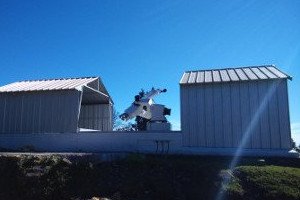
H - Alpha
The H-alpha telescope installed at the Kodaikanal Observatory in October 2014. An objective lens of 20 cm doublet provides f/7.9 beam. With the additional optics, the telescope makes full-disk image of the sun. The telescope is also capable of making magnified view of partial disk of the sun.
Image taken by H-Aplha Telescope
A tunable Lyot filter isolates the H-alpha spectral line. The H-alpha line center image was made with a spectral resolution of 0.4 A. With the 13.5 micron pixel CCD camera the pixel resolution is about 1.21" in full-disk and 0.48" in partial disk mode.
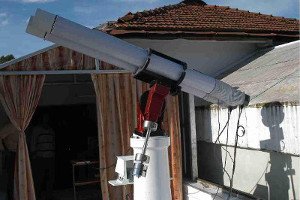
Twin Telescope
Two telescopes mounted on a single equatorial mount. Each telescopes, having 15-cm objective lens makes the full-disk images of the sun in Ca-K (393.37 nm) and white-light. A 2048 X 2048 pixels with 13.5 micron sized CCD camera makes the full-disk images of the sun in Ca-K and white-light with a pixel resolution of 1.25 arc sec. The telescope started making the observations of the sun in Ca-K wavelength and white-light since February 2008. It has stopped making observations in 2012. Now, the observations of the sun in Ca-K wavelength is made using WARM telescope. The calibrated data from 2008 to 2012 is available for scientific research on request.
Image taken by Twin Telescope
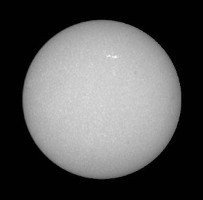
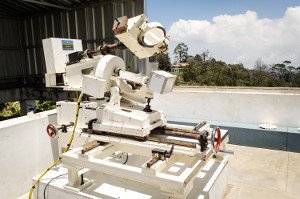
WARM Telescope
Full-disk solar imaging telescope WARM (White light Active Region Monitor) is started making the full-disk observations of the sun since January 2016 at the Kodaikanal Observatory. It has a two-mirror coelostat system which feed sunlight to the 15 cm aperture doublet. The telescope along with additional optics produces two images in perpendicular directions. In one channel full-disk G-band images (at 430.5 nm) and in the other channel red continuum (630.25 nm) images are obtained. From February 2017, the red continuum filter is replaced with Ca-K filter. The WARM telescope is making the fulldisk observations of the photosphere and chromosphere simultaneously.
Image taken by WARM Telescope
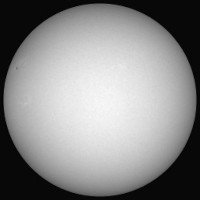
Solar Tunnel Telescope
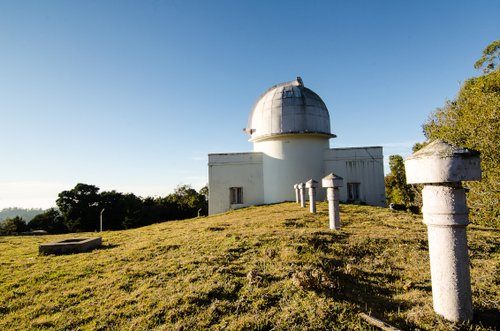
- Telescope
A Grubb Parson 60 cm diameter two-mirror fused quartz coelostat mounted on 11 m tower platform directs sunlight via a flat mirror into a 60m long underground horizontal `tunnel'. A 38 cm aperture f/90 achromat forms a 34 cm diameter solar image at the focal plane. The telescope has an option to mount a 20 cm achromat which provides an f/90 beam to form a 17 cm image.
- Main Spectrograph
A Littrow-type spectrograph is the main instrument at the telescope. A 20 cm diameter, 18m focal length achromat in conjunction with a 600 lines/mm grating gives 9 mm/A dispersion in the fifth order of the grating. Together with the 5.5 arcsec/mm spatial resolution of the image, it forms a high resolution set up for solar spectroscopy. Recording of the spectrum can be done photographically or with a Photometrix 1k x 1k CCD system. A large format CCD system is being procured to enhance the coverage of spectrum especially for the broad resonance lines and the nearby continuum.
- Spectroheliograph
The converging solar beam from the objective can be diverted to a high dispersion spectroheliograph with Littrow arrangement using a 3.43 m achromat. The photographic camera behind the second slit is being replaced by a Raticon linear array and a data acquisition system
Kodaikanal Radio Spectrograph
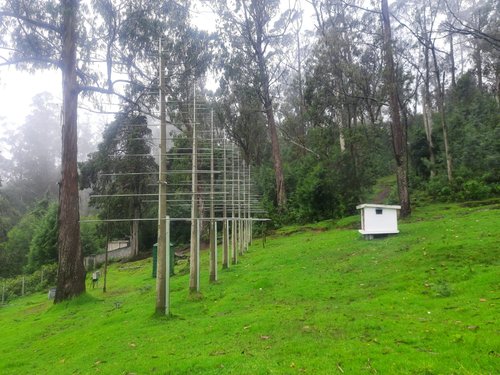
Radio observations of the Sun from the Kodaikanal Solar Observatory (KSO) date back to the early 1950s (A.K.Das, Nature, 1952, Vol.170, p55). Continuous recording of the solar radio noise flux commenced in 1952 using a 100 MHz interferometer with Yagi antennas (A.K.Das and K.Sethumadhavan, Nature, 1953, Vol.172, p446; A.K.Das and B.N.Bhargava, Nature, 1953, Vol.172, p855). These were the earliest solar radio observations in India. A 20 feet paraboloid for observations at frequencies in the decimeter and meter wavelength range was set up on an equatorial mount in 1961. Work on an interferometric aerial for scintillation studies at 60, 100 & 200 MHz simultaneously was also started during this period (B.N.Bhargava and A.P.Jayarajan, J. Inst. Tele. Engg., 1960, Vol.6(5), p231; B.N.Bhargava, J. Inst. Tele. Engg., 1964, Vol.10(8), p404 ). Under the Kodaikanal - Yale Project, recording of radio radiation from Jupiter at a frequency of 22.2 MHz was started using a phase switching interferometer (U.V.Gopala Rao, Proc. Ind. Acad. Sci. 1967, Vol. LXVI, p112). The custom-built 3 GHz wavelength radio receiver from the Commonwealth Scientific and Industrial Research Organization (CSIRO), Australia was put to use in 1965. Mounted on a 2-meter paraboloid, it was used for regular solar patrol. During the late 1960s and early 1970s, small-sized antenna arrays operating at 25 MHz were used to obtain information on the radio bursts from the outer solar corona with high temporal and spectral resolution (Ch.V.Sastry, Solar Phys., 1969, Vol.10, p429; Astrophys. Lett., 1971, Vol.8, p115; Astrophys. Lett., 1972, Vol.11, p47; Solar Phys., 1973, Vol.28, p197; Ch.V.Sastry and K.R.Subramanian, Ind. J. Radio Space Phy., 1974, Vol.3, p196; V.Krishan, K.R.Subramanian and Ch.V.Sastry, Solar Phys., 1980, Vol.66, p347; K.R.Subramanian, V.Krishan and Ch.V.Sastry, Solar Phys., 1981, Vol.70, p375).
During the period 2014-2016, a suite of new facilities for routine observations of the Sun in Halpha, Ca II K and G-band have been installed in KSO. In view of this and with the motive to carry out coordinated multi-wavelength observations of the Sun from the KSO, a new wideband (35-85 MHz) radio spectrograph is being operated in KSO since 2018. Note that though similar low-frequency solar radio spectrographs are operational elsewhere also, the new set-up in KSO offers the unique advantage to quickly organize and carry out high cadence observations of the Sun with the other optical observing facilities in KSO whenever a radio transient is observed. The details about the new radio spectrograph can be found in Indrajit.V.Barve et al., Solar Phys., 2021, Vol.296, p132.